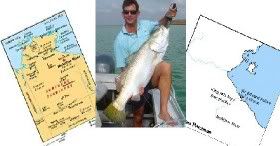
Monday, July 23, 2007
Friday, May 04, 2007
Better barra than a river no more

Thursday, March 01, 2007
Problems in Paradise
 Denis Wilson over at The Nature of Robinson has been burning the midnight oil quite a bit as he does battle for the Kangaloon Aquifer at Robertson in the Southern Highlands of New South Wales. He came across this media item on McArthur River. Miss Eagle has posted from time to time about what is happening in a part of the world beloved to her. See here, here, and here. Miss Eagle posts the item in full. She has no comment - indications within the news item are far too serious.
Denis Wilson over at The Nature of Robinson has been burning the midnight oil quite a bit as he does battle for the Kangaloon Aquifer at Robertson in the Southern Highlands of New South Wales. He came across this media item on McArthur River. Miss Eagle has posted from time to time about what is happening in a part of the world beloved to her. See here, here, and here. Miss Eagle posts the item in full. She has no comment - indications within the news item are far too serious.An article published in the British Journal of Infection has connected high levels of heavy metals in the region with the disease.
The article, written by Top End tropical disease specialist Dr Bart Currie, cites four cases of the disease over the past seven years.
In the first case in 2000, a 55-year-old man who went fishing in rivers near the Nathan River homestead contracted the disease and died two years later.
In May 2001, a 63-year-old man who fished off Vanderlin Island died 18 days later from the disease and in April 2003 a 38-year-old Victorian man had his leg amputated after fishing in the Wearyan River.
As well, a 19-year-old woman died 24 hours after swimming in one of the region's waterways.
The article reported zinc and lead levels downstream from the mine are twice what they are upstream and that it is possible these levels could increase the risk of human infection from the disease.
Mine owner Xstrata say it is aware of the report but it does not link the mine to the cases.
Monday, March 13, 2006
Keep McArthur wild, free, and clean
This report this morning is quite disturbing. This concerns me greatly. I lived at McArthur River Station in 1977 while on a working holiday with my family. This began my love for the river. When I left I promised one day that I would return. 1977 was the year that saw the stealthy declaration of the Borroloola Town Plan by the CLP Government to protect the interest of Mount Isa Mines (MIM) and any future involvement of the river in mine-related activity against the interests of traditional owners – particularly because at that stage a slurry pipeline was being discussed to get the product to port. My husband and I had a close friendship with a Gurdanji traditional owner. At this time the Aboriginal Development Corporation (ADC) was negotiating the purchase of McArthur River Station, on which the Xstrada mine is situated, from Mount Isa Mines. Then one morning people found out that all this effort was for nought. The Northern Territory Government had intervened to protect the interests of MIM.
I kept my promise of 1977. My husband was dead. My children had grown and flown the coop. Sixteen years later, a job came up in Tennant Creek working for the local Member of Parliament in the seat of Barkly. The seat of Barkly covers McArthur River Station, the McArthur River, and Borroloola. I applied. I got the job. I came back. I lived in Tennant Creek from 1993 to 1997. This period covered the gearing up of McArthur River Mine by Mount Isa Mines (MIM) from its previous status as a pilot project. I was used to dealing with MIM because, in the interim, I had spent nearly a decade living and working in Mount Isa. When I consider the agreements made with local aboriginal people by Mount Isa Mines, I don’t believe that the mine has delivered for the interests of local aboriginal people.
For thirty years, I have been concerned with the impact of mining on the pristine McArthur. Now it has become an eventuality.
There is the distinct possibility of a fightback by Xstrada following the NT Govt’s decision against Xstrada’s EIS statement. If this fightback comes about, it will receive strong support from the mining community and will be run by a professional public relations company. Business interests will seek to dominate against the interests of aboriginal people and against the welfare of the local environment.
Human beings know better than this. No amount of dollars - whether it is in the pockets of Australians or the Swiss, in the pockets of corporations or government - can replace the dugong and the turtle (which I have eaten, prepared by an aboriginal clan, beside the McArthur River) if they and their habitat, along with with the barramundi for which Borroloola is famous, are destroyed.

